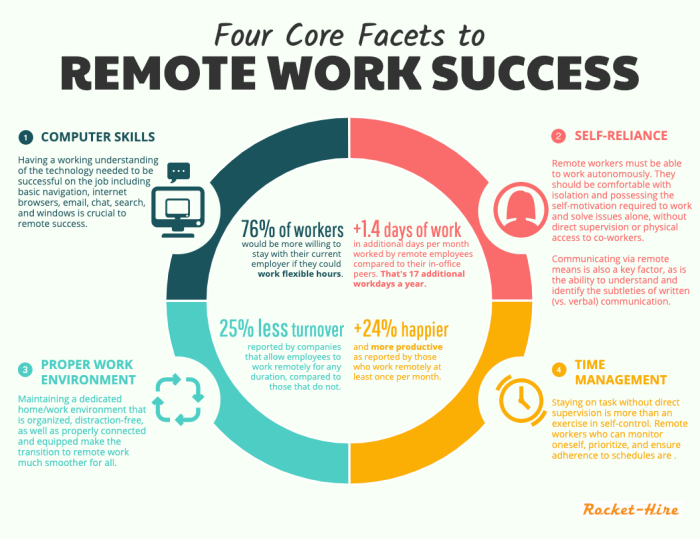Remote Work Productivity: Maximizing Efficiency in a Virtual Environment sets the stage for a deep dive into the world of remote work, offering insights and strategies to boost productivity in a digital landscape.
In today’s fast-paced work environment, the ability to stay productive while working remotely has become crucial for success. From defining remote work productivity to exploring tools and technologies, this guide covers all you need to know to excel in a virtual workspace.
Definition of Remote Work Productivity
Remote work productivity refers to the ability of individuals to efficiently complete tasks, meet deadlines, and achieve goals while working remotely, outside of a traditional office setting. It involves maintaining high levels of performance and output despite not being physically present in a centralized workspace.
Importance of Remote Work Productivity
- Flexibility: Remote work allows individuals to work from anywhere, providing flexibility in managing personal and professional responsibilities.
- Work-Life Balance: By being productive while working remotely, individuals can better balance their work commitments with personal time, reducing stress and burnout.
- Cost-Effectiveness: Increased productivity in remote work settings can lead to cost savings for companies by reducing overhead expenses associated with maintaining a physical office space.
- Employee Satisfaction: Productive remote work environments can contribute to higher levels of job satisfaction and overall employee morale.
Key Factors Contributing to Remote Work Productivity
- Effective Communication: Clear and consistent communication among team members is essential for maintaining productivity in a remote work setup.
- Time Management: Remote workers must effectively manage their time to prioritize tasks, avoid distractions, and meet deadlines.
- Technology and Tools: Utilizing the right technology and tools can streamline workflows, facilitate collaboration, and enhance productivity in remote work environments.
- Establishing Routines: Creating daily routines and setting boundaries between work and personal life can help remote workers stay focused and maintain productivity levels.
Tips for Improving Remote Work Productivity

When it comes to remote work, productivity is key to success. Here are some practical strategies to help you stay focused and efficient while working from home.
Establish a Dedicated Workspace
Creating a designated workspace in your home is crucial for maintaining productivity. This area should be free from distractions and set up in a way that mimics a traditional office environment. Invest in a comfortable chair, a spacious desk, and good lighting to enhance your focus and motivation. By having a dedicated workspace, you can mentally separate work from home life, leading to better concentration and productivity.
Effective Time Management
Time management is essential for remote workers to avoid procrastination and maintain a healthy work-life balance. Create a daily schedule outlining your tasks and deadlines, prioritizing important assignments first. Use tools like time tracking apps or Pomodoro technique to stay organized and focused throughout the day. Set specific work hours and take regular breaks to prevent burnout and maintain productivity levels. Remember, effective time management is the key to successfully juggling work responsibilities and personal commitments while working remotely.
Tools and Technologies for Remote Work Productivity
In today’s remote work landscape, the right tools and technologies can make all the difference in enhancing productivity for remote workers. These tools help streamline communication, collaboration, project management, and overall efficiency in a virtual work environment.
Project Management Software for Remote Teams
Project management software is essential for remote teams to stay organized, track progress, and meet deadlines effectively. Popular options like Trello, Asana, and Monday.com offer features such as task assignment, progress tracking, and deadline reminders. These tools enable team members to collaborate seamlessly, even when working from different locations.
Communication Tools for Remote Work Collaboration
Communication is key in remote work, and tools like Slack and Zoom play a crucial role in facilitating seamless collaboration among team members. Slack allows for real-time messaging, file sharing, and integrations with other productivity tools. On the other hand, Zoom offers video conferencing, screen sharing, and webinar capabilities, making virtual meetings and discussions feel more personal and engaging.
Challenges of Remote Work Productivity

Working remotely comes with its own set of challenges that can hinder productivity. Let’s explore some common hurdles faced by remote workers and strategies to overcome them.
Distractions While Working Remotely
One of the biggest challenges remote workers face is dealing with distractions that are not present in a traditional office setting. From household chores to family members vying for attention, staying focused on work can be tough.
- Set up a dedicated workspace: Creating a designated area for work can help signal to your brain that it’s time to focus.
- Establish a routine: Stick to a schedule similar to what you would follow in an office environment to maintain a sense of structure.
- Use noise-cancelling headphones: Blocking out background noise can help you concentrate better on your tasks.
- Take breaks: Allow yourself short breaks to refresh your mind and prevent burnout.
Setting Boundaries Between Work and Personal Life, Remote Work Productivity
Another challenge of remote work is the blurring of lines between work and personal life, leading to overworking and burnout. It’s essential to establish clear boundaries to maintain a healthy work-life balance.
- Define work hours: Set specific start and end times for work to prevent it from encroaching on personal time.
- Communicate with family members: Let your loved ones know your work hours and when you should not be disturbed.
- Create a shutdown ritual: Develop a routine that signals the end of the workday and helps you transition into personal time.
- Avoid working in common areas: Keep work-related activities confined to your workspace to separate work from leisure.





